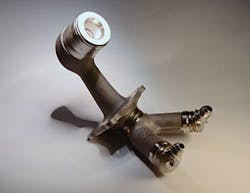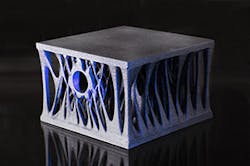IndustryWeek has been naming the Technology Leader of the Year since 1993, selecting the one -- or sometimes two -- innovators, technologists and game-changers that represent the height of technological progress of their day.
Over the years, we have celebrated the achievements of CEOs, inventors and industrial celebrities. We have given the award to comic book superheroes like Elon Musk and corporate giants like GE's Jeff Immelt. Bill Gates is on the list, along with digital pioneers like Netscape's founder Jim Clark. In 2000, we expanded our definition of manufacturing to include the breakthrough efforts of Francis Collins and J. Craig Venter, fathers of the human genome.
Some of these winners have built great teams and steered great companies. Some of them have invented new technologies or applications. Some of them have sought to single-handedly alter the course of human history.
The one thing these winners all have in common is that they've changed the industry around them. These leaders arrived on the scene at the front edge of their fields and provided the last push to achieve gigantic, transformational breakthroughs that echoed through their industries.
These are the legends in the field, the leaders that changed technology forever.
This year, we've selected a quiet entrepreneur from southern Ohio.
Greg Morris is a small business owner, a sixth generation steel worker turned technologist whose small plant in a Cincinnati industrial cul-de-sac has utterly transformed the manufacturing industry.
Morris was the co-founder and CEO of Morris Technologies -- a metal 3-D printing service provider started in 1994 that, until 2012, had been churning out prototypes and parts for local businesses.
His name might not be familiar to some readers -- maybe most outside the 3-D printing crowd -- but his final project with Morris Technologies should be familiar to just about everyone: GE Aviation's 3-D printed fuel injector.
Leading the Revolution
Over the last year, the global conversation around 3-D printing has suddenly changed its tone.
For years, the momentum, the energy and the excitement in additive manufacturing was all about the latest breakthroughs in plastics and polymers. It was about new materials, higher resolution, better prototypes and functional models.
But now the focus has shifted to heavy metal.
Manufacturers have stopped looking at the technology as just a way to prototype and get products to market faster. Now, it's under the industrial lens, being studied by manufacturing engineers as a way to make real parts for real work. It's being used not as a model maker, but an industrial tool that has earned its place next to the CNCs and grinders on the factory floor.
And that is having a palpable effect on the whole 3-D printing industry.
The latest news out of the Wohlers Report shows a 75.8% increase in metal printer machine sales last year. Expectations are for metal sales to nearly double again in 2014 and for a 400% increase in the larger additive industry by 2020.
Airbus is now publicly in the metal printing game, along with SpaceX, Pratt & Whitney, Honeywell and what seems like every other big name manufacturer interested in sticking around.
If you trace that change back to one source, to one moment in the industry, it all points to GE's fuel injector.
Greg Morris, with his small team down in Cincinnati, is the leader that made that happen.
Greg Morris: IW Technology Leader of the Year
Today, Morris works as the additive technologies leader for GE (IW 500/7) Aviation, and his 3-D printing team and factory have been folded into what is becoming an enormous new wing of GE's additive manufacturing works.
In the following interview, IndustryWeek tracked Morris down to discuss his role in this new industrial phase of 3-D printing and what made his team, his plant and his leadership such a catalyst for a revolution 30 years in the making.
IW: First off, congratulations for the Technology Leader of the Year nomination. It has been great watching the impact you've made on the industry these last couple of years.
GM: Thanks a lot, I really appreciate the selection. But I have to tell you, I think this impact is more due to the fact that we have a good team here
We have a great team of people at what used to be Morris Technologies, now the Additive Development Center. They are the real technical experts that have been working through these tough problems of additive.
Whatever impact we've had, it's because of that.
IW: I'm happy you brought that up. I think it was that team focus on real 3-D printing expertise that was the real point of the selection. As I see it, many people in the industry still like to think of 3-D printing as an easy process. Just import the CAD file, hit print and let it run.
But that's not really the case on the industrial side, right?
GM: No, absolutely not.
The technology still needs a certain level of expertise and knowledge and background and capability. There is clearly a human capital shortage to be able to run the machines and to know what you're doing as you run them.
I completely agree that that is the case today. Will that be the case forever? Probably not.
I think the machines will get better and more intuitive and the software programs that are being looked at and being written will do a good job of anticipating stresses and correcting for it before you start to build those kinds of things.
So technologies will catch up, but not for probably a good five years now. Maybe longer.
In the meantime, there are only a handful of people that really know the technology well.
IW: And you are one of them.
GM: That's probably true.
Over the course of time, I think we were one of the teams in the world that figured it out. We certainly had the most capacity for the type of metal printing that we were doing and we really promoted it, and I think promoted it in the right way. We didn't over-promise things; we tried to do it in a way that was responsible for what the customer could expect.
3-D Printed Knowledge
IW: So how did that happen? How did your shop develop so much expertise? Why was Morris Technologies -- of all the print shops and all the giant corporate R&D departments in the world -- the one to figure it all out?
GM: Ultimately, I think we just started to figure out how to build these parts on our own. Early on, we had a lot of big clients like GE and Johnson & Johnson, a lot of big aerospace, automotive and military organizations.
A lot of the files and components that we were trying to produce for them were what we call "export control," meaning that we were doing work where the file couldn't be seen by a foreign national.
So when we had problems, we had to figure them out on our own. It was do or die to figure it out.
We either were able to build them or we weren't, and I think ultimately our success depended on having enough tenacity to say we're going to keep rebuilding until we figure out the best orientation, maybe the best support structure strategy, those types of things.
We didn't patent things. We kept trade secrets about how we supported our parts or oriented the parts or finished the parts. That was a lot of what we did. We modified some of the equipment to give us capabilities that no one else had.
So basically, month by month, we learned a great deal about the process.
Over time, we created capability. We created knowledge, we created IP that we translated then to methods and ways of supporting parts and making parts that no one else knew because we had to go through that tough learning curve.
All of that eventually added up. By 2012, we were probably one of the better 3-D printing teams in the world.
IW: 2012 was the big year -- that was when GE finally bought your company and announced its plans to start printing these fuel injectors. From my perspective, that seemed like the moment when everything changed in the additive world.
GM: I agree. When GE bought us, I think that validated for the industry that this technology was a technology that can be used in end use parts on the manufacturing floor. Everybody knew that when GE bought us, they purchased us not for the prototyping capabilities, but to scale it for production.
Since that time, that's really been the story. GE is moving toward production using this technology to make end use parts to go into one of the harshest parts of the engine, the combustion chamber area, and I don't think anything can validate the technology more quickly or, frankly, more convincingly than that.
And when people see one of the world's largest corporate conglomerates accepting the technology and using it, I think they realize this must be real. GE is not a company to go off on a whim and do something. There is something behind this technology that we need to get involved in and take a look at.
That's why we've seen the proliferation of the technology over the last few years.
GE & New Beginnings
IW: Tell me about the transition to GE. That was a big jump for you and your team, of course, but also a big jump for the corporation.
The fuel injector is a great piece, but with all of the investment they've thrown behind you and 3-D printing in general, this seems like only the beginning.
GM: I've never actually worked for a corporation before, so this is all very new for me. But so far, it's been pretty impressive.
GE Aviation and GE as a whole, they're obviously a very large company, but also a very progressive company. A very innovative company.
You see that by virtue of the huge swing that they've taken with their first additive component they're going to put onto a gas turbine engine and fly around with.
I think that talks volumes about innovation and the spirit of entrepreneurialism that GE has, as large as they are.
I think GE had the foresight to go do the fuel nozzle and then they took the risk of saying, this technology, even though we're still proving it out and have some technical obstacles to overcome, we believe this is the means to the end of making something you can't make any other way.
And I think their vision goes much further than the fuel nozzle.
It suggests that they could have immediate wins with the nozzle, but looking down the road to other areas and other components of the engine, I think they looked at our domain expertise and our capacity and thought it would be a great stepping off point to leverage what they've done -- significantly invest and grow it. Invest in the technology, invest in the knowledge and be able to apply what we've been able to do with the fuel nozzle to many other components on the gas turbine engine and get performance improvements, weight reductions, which get you tremendous fuel savings.
I think it's just part of their innovation in general.
IW: So where do we go from here?
GM: Frankly now that the spark has been ignited, I expect to see pretty substantial growth in the industry. For additive in general, but certainly for metals.
And really, this is just the start of it.
I know it sounds kind of funny to say, having worked with the technology for 10 years now, but I still think we're just in the beginning.







